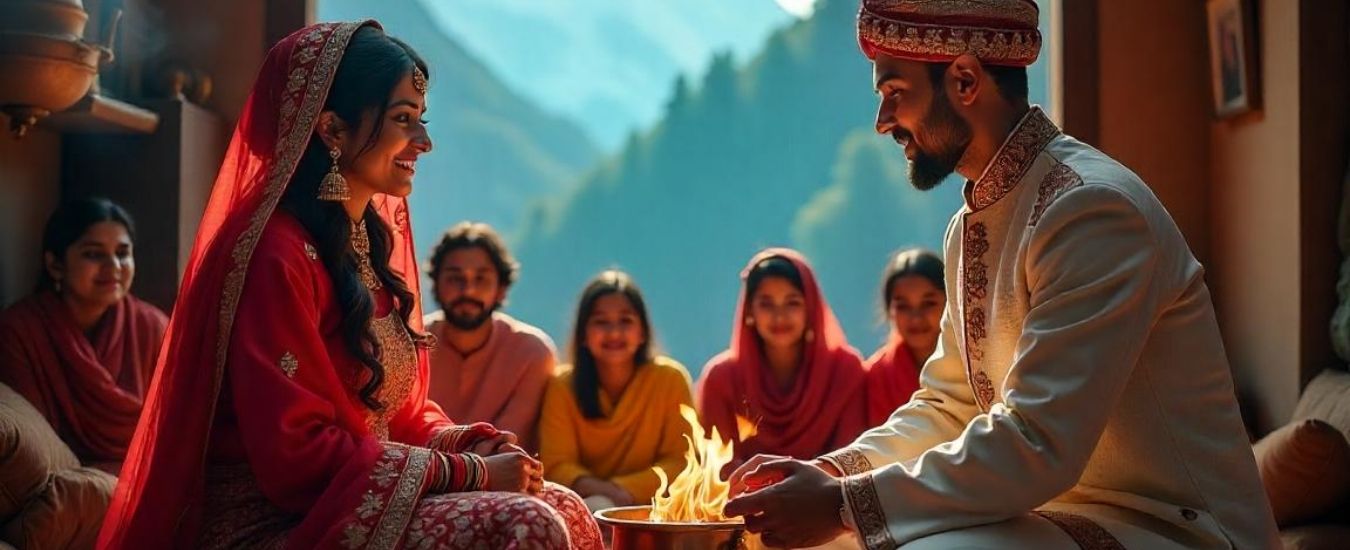Kashmiri weddings are a spectacular blend of heritage, devotion, and celebration. From pre-wedding customs to post-marital traditions, they weave together faith, family, and festivity. Every element, from dejhoor to Wazwan, tells a tale of legacy and love.
Kashmir – the land of snow-capped mountains, serene valleys, and breathtaking landscapes – is not just a scenic paradise. It’s also a place where rich cultural heritage, multi-faith traditions, and vibrant matrimonial customs blend seamlessly to create one of the most soul-stirring marriage experiences in India.
A Kashmiri wedding isn’t just a ceremony – it’s a full-blown celebration, complete with Quranic blessings, music, rituals, emotions, and, of course, the legendary Wazwan feast.
Let’s take a joyful stroll with Aagrah Banquet through the lanes of Kashmiri weddings and unravel the customs that make them so unique.
Introduction to Kashmiri Weddings
A Glimpse into Kashmir’s Rich Culture
Before we dive into the rituals, it’s essential to understand the cultural backdrop. Kashmir is a melting pot of traditions – from Persian architecture to Mughal elegance, Sufi mysticism, to local Pahadi warmth. Its people, known for their hospitality, reflect these blended influences in every ceremony – especially weddings.
The Essence of Kashmiri Matrimony
Unlike many Indian weddings that lean heavily on pomp, Kashmiri weddings balance simplicity with sacredness. They are deeply spiritual, with an emphasis on communal harmony, gender roles, and ancestral honour.
Pre-Wedding Rituals in Kashmiri Culture
Kasamdry (Formal Engagement)
This marks the start of the journey. Kasamdry is the engagement ceremony where families exchange gifts and formally seal the alliance, often in the presence of Qazi and elders for Dua-e-Khair.
Livun – A Cleansing Ritual
Livun is held days before the wedding to purify both households. It symbolizes the purification of space and soul, a form of spiritual hygiene.
Maenzraat – The Mehndi Night
During Maenzraat, the bride’s hands are adorned with henna as wanwun songs echo in the background. The atmosphere is lit with walnut wood lamps, laughter, and anticipation.
Waza Preparation and Family Feast
Skilled Wazas begin cooking the Wazwan, a feast of up to 36 courses. Dishes like Tabak Maaz, Modur Pulav, and Aab Gosht simmer for hours. The aroma, seasoned with saffron and love, is unforgettable.
Wedding Day Traditions
Nikah – The Islamic Wedding Contract
For Muslim Kashmiris, the Nikah is the spiritual highlight, performed by a Qazi, documented in a Nikahnama, and blessed with Mehr – the dower. The bride and groom may remain in separate rooms, reflecting modesty and reverence.
Traditional Attire – Kashmiri Elegance
Brides wear a red pheran, paired with the stunning tarang and dejhoor (ear ornament), symbolic of marital status. Grooms don karakul caps, embroidered pherans, or sherwanis with regal poise.
Dastar Bandi – Groom’s Honor Ceremony
The Dastar Bandi ceremony, tying the groom’s turban, represents readiness for marriage and is often accompanied by blessings from elders.
The Majestic Wazwan
The Wazwan is not just food; it’s an art form. Dishes like Gushtaba, Rista, and Rogan Josh are presented in tarami (copper plates) and served with etiquette. It’s a culinary bridge between families.
Post-Wedding Customs
Ruksati – The Farewell
Ruksati marks the bride’s departure, often emotional and tearful. It’s steeped in respect, ritual recitation, and gifts from the family.
Muhar Tullun – Welcoming the Bride
The bride is welcomed with traditional sweets, chants, and blessings. Kangri (earthen firepot) may be offered for warmth, symbolizing warmth in relationships.
Phir Saal – First Visit to Her Parental Home
Phir Saal is the bride’s return with her husband for a short stay. Gifts, sweets, and bond-strengthening rituals accompany this joyful visit.
Cultural and Spiritual Symbolism
Sufi Influence and Simplicity
The Sufi philosophy inspires many Kashmiri wedding rituals – simple, soulful, and symbolic. It adds depth and mystic connection to every step.
Music, Dance, and Cultural Pride
Traditional instruments, folk poetry, and spiritual songs like wanwun preserve Kashmiri ethos. Dance is minimal but expressions are rich with symbolism.
Food as a Cultural Statement
The Wazwan is not only a feast but also a cultural identifier. Its preparation, presentation, and consumption represent craftsmanship, hospitality, and unity.
Modern Influences on Kashmiri Weddings
Changing Traditions and Urban Impact
From destination weddings in Srinagar to fusion catering and wedding planners, modern touches are seen. Yet many families retain the soul of their traditions.
Social Media, Decor, and Wedding Planners
From hashtags like #KashmiriWeddingGoals to drone videography, the visual storytelling of Kashmiri weddings has changed, but the spiritual thread remains.
So, whether you’re attending or planning one, get ready for an emotional, spiritual, and sensory journey that will leave lasting memories.
FAQs
What is the traditional dress of a Kashmiri bride?
A Kashmiri bride typically wears a red or maroon pheran with a traditional headgear called tarang, adorned with jewelry and embellishments reflecting Kashmiri elegance.
How many days does a typical Kashmiri wedding last?
Traditional Kashmiri weddings span over 5 to 7 days, including multiple pre-wedding, wedding, and post-wedding rituals.
What is the Wazwan, and why is it important?
Wazwan is a multi-course traditional Kashmiri meal (up to 36 dishes), symbolizing hospitality, celebration, and cultural pride. It’s an essential part of the wedding feast.
Is music a part of Kashmiri weddings?
Yes, especially traditional wanwun songs sung by family members during pre-wedding gatherings. It’s soulful, poetic, and deeply cultural.
Are Kashmiri weddings only Islamic in nature?
While most Kashmiri weddings follow Islamic customs, there are Hindu Kashmiri Pandit weddings too, which follow distinct yet equally rich rituals and traditions.
